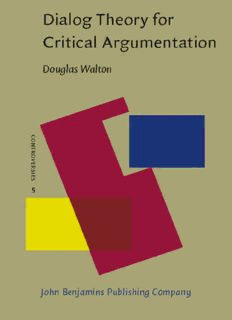
Dialog Theory for Critical Argumentation (Controversies) PDF
Preview Dialog Theory for Critical Argumentation (Controversies)
Dialog Theory for Critical Argumentation Controversies (CVS) Controversies includes studies in the theory of controversy or any of its salient aspects, studies of the history of controversy forms and their evolution, case- studies of particular historical or current controversies in any field or period, edited collections of documents of a given controversy or a family of related controversies, etc. The series will also act as a forum for ‘agenda-setting’ debates, where prominent discussants of current controversial issues will take part. Since controversy involves necessarily dialogue, manuscripts focusing exclusively on one position will not be considered. Editor Marcelo Dascal Tel Aviv University Advisory Board Harry Collins Kuno Lorenz University of Cardiff University of Saarbrücken Frans H. van Eemeren Everett Mendelssohn University of Amsterdam Harvard University Gerd Fritz Quintín Racionero University of Giessen UNED, Madrid Fernando Gil † Yaron Senderowicz Ecole des Hautes Etudes en Sciences Tel Aviv University Sociales, Paris Stephen Toulmin Thomas Gloning University of Southern California University of Marburg Ruth Wodak Alan G. Gross University of Vienna University of Minnesota Geoffrey Lloyd Cambridge University Volume 5 Dialog Theory for Critical Argumentation Douglas Walton Dialog Theory for Critical Argumentation Douglas Walton University of Winnipeg John Benjamins Publishing Company Amsterdam / Philadelphia TM The paper used in this publication meets the minimum requirements of 8 American National Standard for Information Sciences – Permanence of Paper for Printed Library Materials, ansi z39.48-1984. Library of Congress Cataloging-in-Publication Data Walton, Douglas N. Dialog theory for critical argumentation / Douglas Walton. p. cm. (Controversies, issn 1574-1583 ; v. 5) Includes bibliographical references and index. 1. Dialectic. 2. Logic. 3. Reasoning. I. Title. B809.7.W355 2007 160--dc22 2007025817 isbn 978 90 272 1885 8 (Hb; alk. paper) © 2007 – John Benjamins B.V. No part of this book may be reproduced in any form, by print, photoprint, microfilm, or any other means, without written permission from the publisher. John Benjamins Publishing Co. · P.O. Box 36224 · 1020 me Amsterdam · The Netherlands John Benjamins North America · P.O. Box 27519 · Philadelphia pa 19118-0519 · usa For Karen with love Table of contents Acknowledgements xi Acronyms xiii Introduction: Dialog theory for critical argumentation xv chapter 1 The place of dialog theory 1 1 The rebirth of dialog theory 2 2 Dialog theory in computing 1 0 3 Agent communication 15 4 Fundamental concepts of dialog theory 20 5 The critical discussion as a type of dialog 25 6 Plan recognition and deliberation 29 7 The BDI model and the commitment model 34 8 The problem of retraction 36 9 Communication and information 40 10 The future and past of dialog theory 43 chapter 2 The history of dialectic 47 1 Origins of dialectic in ancient philosophy 48 2 The dialectic of Socrates and Plato 51 3 Aristotelian dialectic 56 4 Aristotle’s classification of types of dialog 62 5 Medieval dialectic 65 6 Dialectic in modern philosophy 68 7 The re-appearance of dialectic 71 8 Eight characteristics of dialectic 74 9 Hamblin’s dialog rules 79 10 Functions of questioning and asserting 82 11 The future of dialectic as a subject 86 Dialog Theory for Critical Argumentation chapter 3 Persuasion dialog 89 1 Persuasion in rhetoric and dialectic 90 2 Characteristics of persuasion dialog 95 3 Defeasibility and acceptance 101 4 Evidence, testing, and burden of proof 106 5 Dialogs, truth and relativism 110 6 The charge of pernicious relativism 112 7 Judging the maieutic depth of a persuasion dialog 116 8 Aiming at the truth 121 9 Truth, evidence and acceptance 124 10 Conclusions 127 chapter 4 Mutlti-agent dialog systems 131 1 Agent communication systems 132 2 Speech acts 137 3 Interrogative messages in ACL’s 140 4 Conversation policies 143 5 Sincerity conditions 145 6 Understanding of messages 148 7 Rational effects of a message 151 8 Future multi-agent systems and dialog theory 153 chapter 5 Agents in critical argumentation 159 1 The case of the critical discussion on euthanasia 160 2 Fallacy and deception 164 3 Current systems of formal dialectic 167 4 Implicit commitment and Gricean implicature 173 5 Adding speech acts and agents to formal dialectic 176 6 What characteristics of an agent are needed? 180 7 Expectations and plausible inference 185 8 Plans, strategies and chaining forward 187 9 Strategies in formal dialectic 191 10 Qualities of character for agents in formal dialectic 200 Table of contents chapter 6 Dialectical shifts and embeddings 205 1 Dialectical shifts and fallacies 206 2 The problem of shifts and embeddings 212 3 Cases of shifts based on embeddings 216 4 Cases of shifts not based on embeddings 221 5 Argumentation schemes 226 6 Analysis of the cases based on embeddings 230 7 Analysis of the cases not based on embeddings 233 8 Fitting dialogs together at global and local levels 235 9 Metadialogs 239 10 Solving the embedding problem 241 chapter 7 Criticizing a natural language argument 247 1 Explanation, clarification and interpretation 248 2 The three stages of critical assessment 253 3 Plan recognition and incomplete arguments 256 4 New tools for argument diagramming 261 5 The problem of enthymemes 265 6 Three bases for the enthymeme 268 7 Textual interpretation as an abductive process 274 8 Textual interpretation as simulative 277 9 Anticipating an arguer’s future moves 281 10 The problem of diffuse dialog 284 Bibliography 289 Index 303
